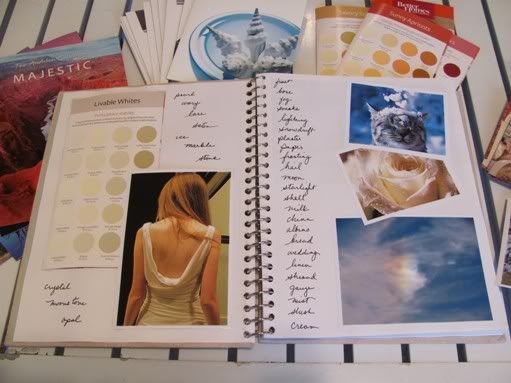Color referencing in fiction can be tricky, as I think the writer's first tendency is to grab a cliche or relate something to food. Who hasn't read at least one story in which a frightened character went white as a sheet, or possessed flawless creamy-white skin? But we know this is really lazy writing, and we owe the reader a bit more originality and effort.
I started my notebook with white, which happens to be my color reference nemesis. I discovered how difficult it is to describe white when I made the eyes of my Jorenian characters in the StarDoc series that color -- and subsequently cursed myself for doing so for the next thirteen years. All my color references to white were contemporary, and here I was writing in a far future where 99% of them didn't exist. Anyway, most of the time I fell back on a blind-person analogy or the white-within-white thing. It was lame, and it's probably the reason I started collecting color references in the first place, to broaden my understanding of color as well as beef up my descriptive powers.

We all see and respond to color differently, so this kind of notebook is a great exercise in originality. You can put anything that inspires you in a color reference notebook; what you want is something that naturally stimulates your powers of description. I find combining paint charts and photos with word lists related to the color usually primes the well for me, but I also plan to use cover art, scanned images from my favorite magazines (Artful Blogging has tons of ladies who do the all-white decorating thing) as well as poems I associate with particular colors or palettes. Here's a page with Stopping by Woods on a Snowy Evening by Robert Frost, definitely my #1 white poem:

A color reference notebook is also a good storage encyclopedia for references you've already used in stories past. This can help prevent you from becoming that a descriptive repeater who in every book has a character with chocolate brown eyes or flaming red hair. Doesn't seem like it would be a problem, but wait until you've written twenty or thirty novels and suddenly you notice that every other guy character you write has laser-beam blue eyes.
What would you put in a color reference notebook to help jog your descriptive powers? Let us know in comments.
Related posts: Palettes with Color Names ~ Story Palettes ~ Character Palettes

Lists and swatches from paint manufacturers. I'm in the middle of choosing a color for a bedroom, and noticing that the makers are pretty good at choosing descriptive names.
ReplyDeleteSwipes of nail polish. Like raine, I've noticed the makers are really good at choosing names. Sometimes descriptive names, but sometimes just cool names. One of my faves from when I was 12 or so is Megawatt, a gold-glitter color. That one inspired a (truly horrid) sci-fi story at the time.
ReplyDeleteNow you've got me all inspired. I never thought to put my love (and research) of color into one notebook. I know what I'm starting later this week! Thanks :)
Lovely idea! I would never have thought of doing this on my own. Thank you for the examples and the reasons why it's a good idea - definitely we can get into lazy habits, and I worry about mine.
ReplyDeleteBest color reference scene? The cerulean scene in The Devil Wears Prada--movie version with the remarkable Meryl Streep giving a discourse on cerulean. My daughter and I still occasionally look at the sky and say, "What a beautiful cerulean." After which we both crack up.
ReplyDeleteBest wishes,
Joan Reeves
You might get some ideas for color from cars. We once owned a car with the color metallic turquiose. Think what eyes this color would like. I never thought of doing this, but it would be great. I will have to start my own color notebook.
ReplyDeleteRobin wrote: I'll have to start my own book. Any recommendations on how to get started?
ReplyDeleteI really started working on mine by collecting paint chips and palettes, which I think is the easiest way. You can pick up these for free from most home improvement and big box stores like K-Mart. If that's not convenient, I'd put together some folders, label each one with a color according to the color wheel, and start collecting photos, images from the internet, magazine clippings, or anything that illustrates color in an inspirational fashion for you. Don't be afraid to use an unusual source, either. Some of the ideas already mentioned, like nail polish and cars, are really neat alternatives. Check you junk mail, too -- I often find great color-descriptive words in yarn catalogs.